
Catapults & Ski Ramps
Based on a number of sources including Dr. Friedman's book on "US
Aircraft Carriers [Ref CV1], the book "Farnborough and the Fleet air
Arm" by Geoffrey Cooper [Ref CV2], the report "The Strike Carrier:
Considerations in the Selection of Her Size and Principal Design
Characteristics" by Manley St. Denis as published in the Transactions
of the Society of Naval Architects and Marine Engineers 1966 [Ref CV3],
the paper "Design Aspects of the New SERD Catapult" by R.L. Brace and
J.E. McWade as published in the Journal of the American Society of
Naval Engineers in February 1977 [Ref CV4], a presentation on the
"ICCALS Internal Combustion Catapult Aircraft Launcher" by Clint
Stallard of Stallard Associates [Ref CV5], and general internet
searches I've attempted to collect information on the modern steam and
electro-magnetic catapult systems used on post WWII aircraft
carriers. From this data I have tried to develop some trendlines
and "rules of thumb" to assist in assessing the total weight impact of
such systems on a ship's design, so that I can both try to adjust the
raw weight data for the ships and designs that I have information on as
well as to allow a designer to make an assessmt of the weight impact of
trying to fit such equipment onto a new design.
Steam Catapult Information & Trendline Data
In general catapults fall into SWBS group 587 Aircraft Launch Support
Systems. However, in general such systems will have additional
weight impacts on other systems, including for foundations (a SWBS 100
weight item) and various piping and related systems (other SWBS 500
groups) as well as the weight of the Catapult Trough and Trough Covers
as well as any structural reinfircements in way of the catapults and
troughs (which I believe will be SWBS 100 items). In accordance
with Ref CV4 it is possible that for a relatively modern C-13 type
steam catapult the over all weight impact to accomodate such a system
may by into the 1000's of tons. As such, in addition to the
weights of the individual catapult systems, I have also tried to
collect infomation on the other weight impact and make an assessment of
what the total weight impact for the installation of a catapult onboard
a vessel may be. Unfortunately, this assessment is probably
fairly rough, but it is the best that I have been able to come up with
so far, but I hope to continue to try and revise it as I collect
additional supporting information.
Based on information in Refs CV1 & CV2 and the like I have been able to put together the following information;
Based on information in Refs CV1 & CV2 and the like I have been able to put together the following information;
| Launch Assist Items | Pwr Stroke | Track Length | Max E | Cat Wt |
|---|---|---|---|---|
| (ft) | (ft) | (ft-lb) | (LT) | |
| UK BS4 | 103.0 | 160.0 | 17,000,000 | 275.0 |
| UK BS5 | 151.0 | 220.0 | 30,000,000 |
|
| UK BS6 | 250.0 | 320.0 | 38,197,700 * |
|
| US C7 | 253.0 | 276.0 | 42,000,000 | 352.0 |
| US C11 | 211.0 | 225.0 | 36,096,827 * |
|
| US C11-2 | 150.0 |
|
23,500,000 |
|
| US C13-0 | 249.8 | 264.8 | 54,000,000 |
|
| US C13-1 | 309.7 | 324.8 | 69,422,255 * |
|
| US C13-2 | 306.8 | 324.8 | 75,000,000 | 478.0 |
| US C13-3 | 246.0 |
|
60,744,473 * |
|
| US Notional 1953 Design |
|
|
135,349,047 * | 650.0 |
Where Max E represents the Launch Energy that the catapult can develop
in foot-lb, which was either specifically listed for some catapults or
which (for those maerked with an *) was estimated by calculation based on the stated launch weight
and speed of various aircraft that the catapult was listed as being
able to support (ie, the US C-13-2 catapult is stated as being capable
of launching an 80,000lb aircraft at 140kt, which equates to an energy
of 69,422,255 foot-lb). Based on this data I plotted Weight
versus Launch Energy as shown below.
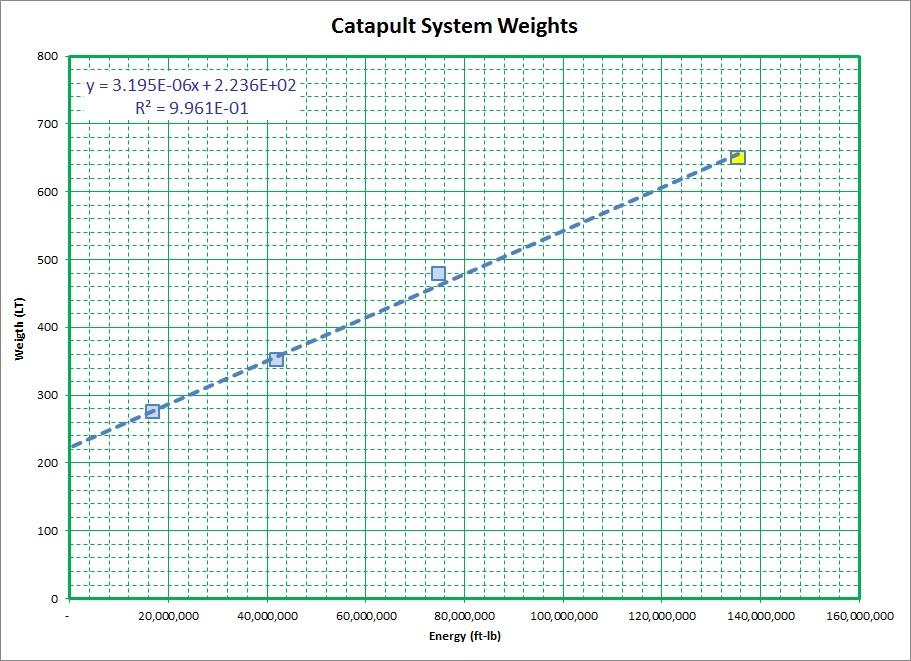
In this figure the upper point has been shaded Yellow to signify that
the Max Energy for that point ws derived from its stated performance
rather than being a listed max energy value.
Although this data is limited, it still appears to show a fairly linear relationship between the catapult system weight (SBS 587) and the maximum energy to be produced by the catapult, and as such it has been used to develop weight estimates for the other catapults listed in the table above and/or to provide a designer with a means of estimating the weights of other similar systems.
However, as noted above, the total weight impact of an installation would also need to address several additional items such as operating fluids, spares and special tools, steam and drain piping, foundations, the catapult trough, the trough covers and other structural mods in way of these.
In ship weight estimating the Spares and Special Tools weight (SWBS 599) and Structural Foundations weights (SWBS 185) are sometime often taken as a percent addition to the system's weight. Along these lines I have assumed the following;
SWBS 185 - Structural Foundations - 8.84% of all SWBS 500 Items
SWBS 599 - Spares and Special Tools - 0.15% or so of the SWBS 500 Items
For the steam and condensate drain piping (which I think would be part of SWBS 535) Ref CV5 gives a value of about 22.0 LT for a C-13-2 catapult if I am understanding correctly.
In addition, on the internet I was able to locate some documentation reelating to the repair of Trough Covers (part of SWBS 130) for a set of C-13 catapults which indcated that each catapult was covered by 81 sets of covers weighing 1800lb each [Rev CV6].
Finally, based on some photographs of the fitting of catapults on the French Carrier de Gaulle (provided by a poster on a Warship Forum [Ref CV6]) and some arrangment drawings for the French Carriers Clemanceau and Foch [Ref CV7] as well as the USS Saratoga CV60 [Ref CV8], that were available on the internet I have made an estimate of the what I believe would be the overall weight impact of the catapult trough, trough covers and other structrual modifications in way of the installation of a C-13-2 steam catapult, as shown below.
Although this data is limited, it still appears to show a fairly linear relationship between the catapult system weight (SBS 587) and the maximum energy to be produced by the catapult, and as such it has been used to develop weight estimates for the other catapults listed in the table above and/or to provide a designer with a means of estimating the weights of other similar systems.
However, as noted above, the total weight impact of an installation would also need to address several additional items such as operating fluids, spares and special tools, steam and drain piping, foundations, the catapult trough, the trough covers and other structural mods in way of these.
In ship weight estimating the Spares and Special Tools weight (SWBS 599) and Structural Foundations weights (SWBS 185) are sometime often taken as a percent addition to the system's weight. Along these lines I have assumed the following;
SWBS 185 - Structural Foundations - 8.84% of all SWBS 500 Items
SWBS 599 - Spares and Special Tools - 0.15% or so of the SWBS 500 Items
For the steam and condensate drain piping (which I think would be part of SWBS 535) Ref CV5 gives a value of about 22.0 LT for a C-13-2 catapult if I am understanding correctly.
In addition, on the internet I was able to locate some documentation reelating to the repair of Trough Covers (part of SWBS 130) for a set of C-13 catapults which indcated that each catapult was covered by 81 sets of covers weighing 1800lb each [Rev CV6].
Finally, based on some photographs of the fitting of catapults on the French Carrier de Gaulle (provided by a poster on a Warship Forum [Ref CV6]) and some arrangment drawings for the French Carriers Clemanceau and Foch [Ref CV7] as well as the USS Saratoga CV60 [Ref CV8], that were available on the internet I have made an estimate of the what I believe would be the overall weight impact of the catapult trough, trough covers and other structrual modifications in way of the installation of a C-13-2 steam catapult, as shown below.
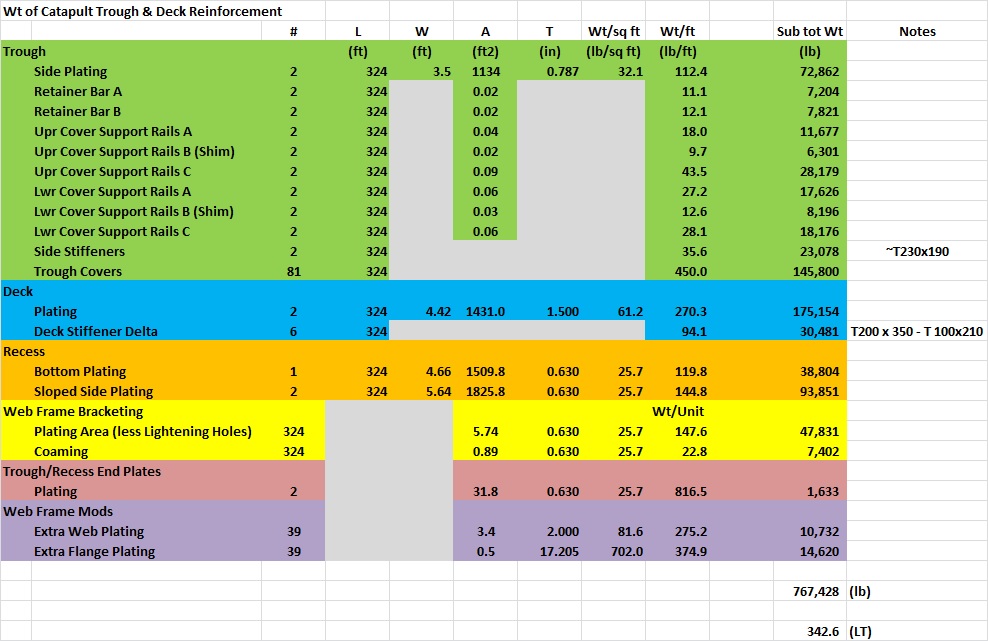
In these calcs a deck thickness of 1.5 inches was assumed based on data
from a CV60 Website and items called out in the above calcs are
identified in the annotated images below [many of which were provided
via Ref CV6].
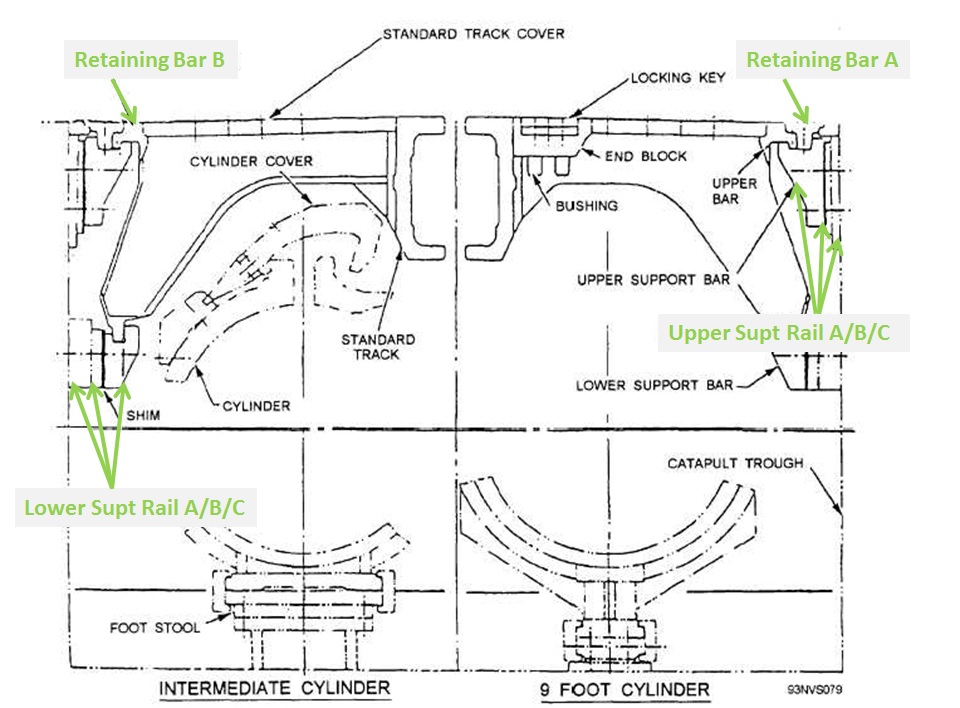
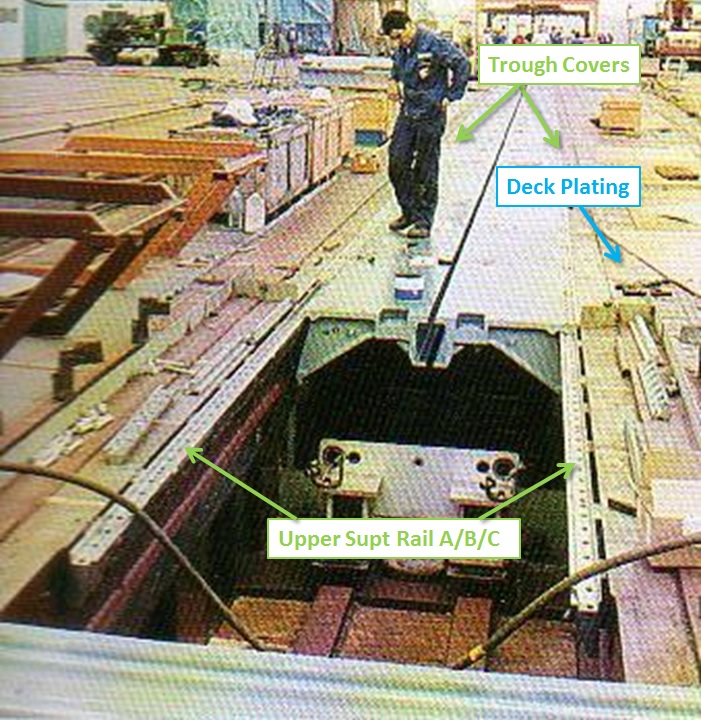

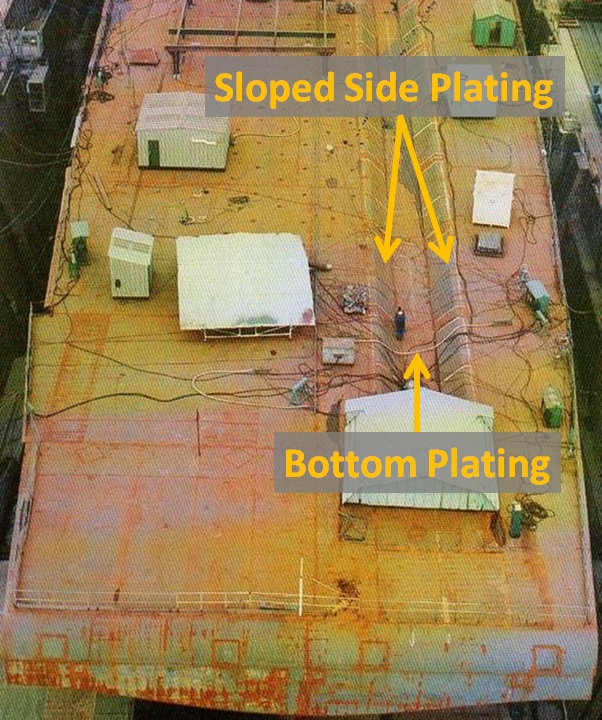
With repect to the Web Frame Mods
listed in the table above, as shown in this image of the arrangmeents
of the French Carrier Foch it appears that the web frames in way of the
catapult troughs may get revised/altered in shape around the catapult
trough and deck recess. As such an estimate was made to account
for the extra web and flange plating of these web girders, making some
assumptions on their size based on the data provided in the drawings of
the Foch and Clemanceau.
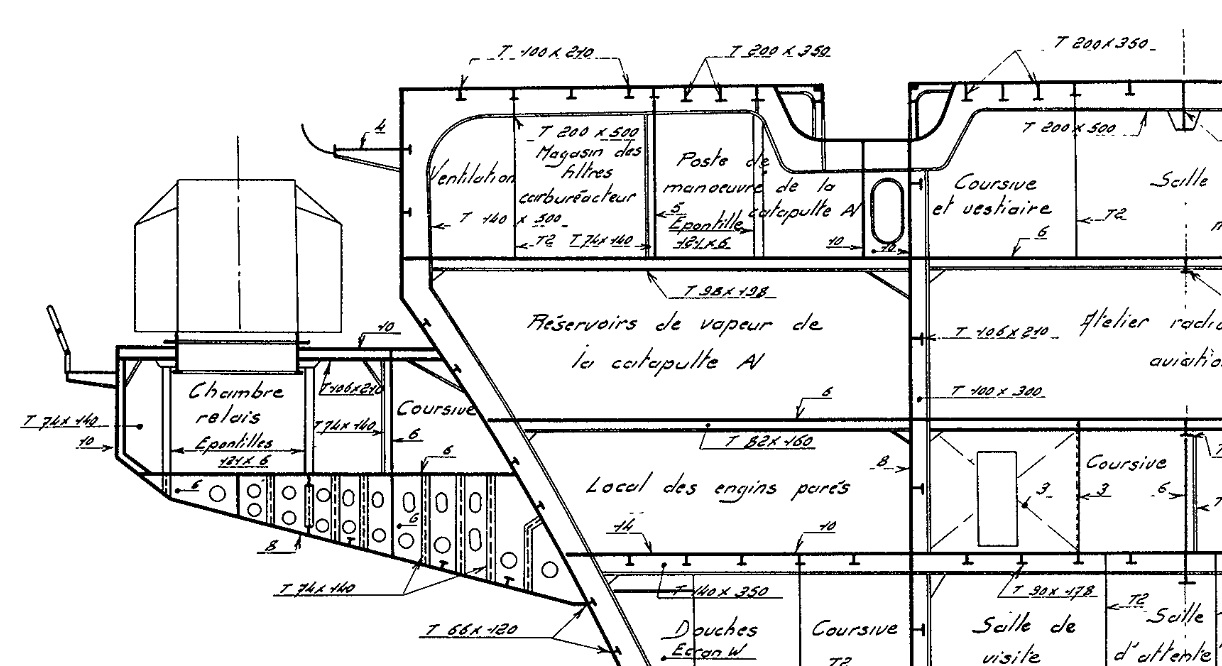
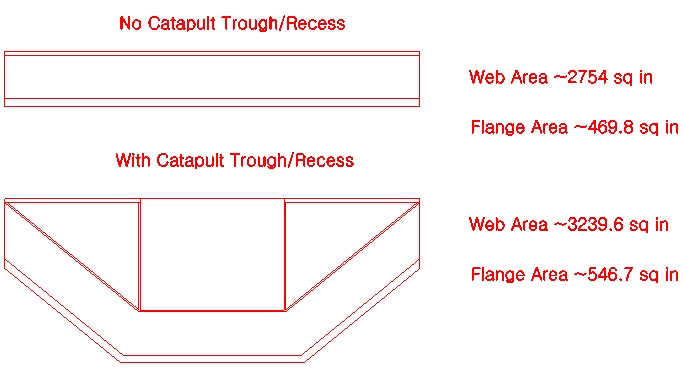
Based on the above information it was roughly estimated that the
Catapult Trough, Trough Covers, Deck Recess and other structural mods
around the installation of a C-13-2 may add something on the order of
an additional 343 LT to the SWBS 100 weight group.
Using all the above information, including the piping, spare parts, foundations and other structural mods etc I roughly estimated that that total SWBS 100 group weight impact from the installation of a C-13-2 Steam Catapult may be on the order of about 389 LT and the total SWBS 500 group weight impact might be on the order of about 522 LT. In these estimates I was not able to try and address if there may be any additional impacts to things like insultation weights and/or an increase in air conditioning plant weight due to any extra height generated by the installtion of steam catapults, but I figured these estimates may be at least a starting point for assesing the impacts of steam catapult installations.
Next I made a rough assumption that the SWBS 100 and 500 weight impacts for the C-13-2 catapult above may scale with with weight of the actual catapult (SWBS 587 group) for other type installations. And I also made an assumption that the track length of the C-11-2 catapult may following a similar trend in comparison to its power stroke as other US catapults appear to do, in order to populate some fo the blanks in the table above. A revised table with additional items estimated is shown below and is included in the spreadsheet to allow a user to investigate alternate catapult installations.
Using all the above information, including the piping, spare parts, foundations and other structural mods etc I roughly estimated that that total SWBS 100 group weight impact from the installation of a C-13-2 Steam Catapult may be on the order of about 389 LT and the total SWBS 500 group weight impact might be on the order of about 522 LT. In these estimates I was not able to try and address if there may be any additional impacts to things like insultation weights and/or an increase in air conditioning plant weight due to any extra height generated by the installtion of steam catapults, but I figured these estimates may be at least a starting point for assesing the impacts of steam catapult installations.
Next I made a rough assumption that the SWBS 100 and 500 weight impacts for the C-13-2 catapult above may scale with with weight of the actual catapult (SWBS 587 group) for other type installations. And I also made an assumption that the track length of the C-11-2 catapult may following a similar trend in comparison to its power stroke as other US catapults appear to do, in order to populate some fo the blanks in the table above. A revised table with additional items estimated is shown below and is included in the spreadsheet to allow a user to investigate alternate catapult installations.
| Launch Assist Items | w100+ | w500+ | Pwr Stroke | Track L | Max E | Cat Wt |
|---|---|---|---|---|---|---|
| (LT) | (LT) | (ft) | (ft) | (ft-lb) | (LT) | |
| UK BS4 | 223.7 | 300.4 | 103.0 | 160.0 | 17,000,000 | 275.0 |
| UK BS5 | 259.8 | 349.0 | 151.0 | 220.0 | 30,000,000 | 319.5 |
| UK BS6 | 281.1 | 377.6 | 250.0 | 320.0 | 38,197,700 | 345.6 |
| US C7 | 286.3 | 384.5 | 253.0 | 276.0 | 42,000,000 | 352.0 |
| US C11 | 275.7 | 370.3 | 211.0 | 225.0 | 36,096,827 | 338.9 |
| US C11-2 | 242.9 | 326.3 | 150.0 | 162.4 | 23,500,000 | 298.7 |
| US C13-0 | 322.2 | 432.8 | 249.8 | 264.8 | 54,000,000 | 396.1 |
| US C13-1 | 388.8 | 522.2 | 309.7 | 324.8 | 69,422,255 | 445.4 |
| US C13-2 | 388.8 | 522.2 | 306.8 | 324.8 | 75,000,000 | 478.0 |
| US C13-3 | 339.7 | 456.3 | 246.0 | 261.0 | 60,744,473 | 417.7 |
| US Notional 1953 Design | 528.7 | 710.1 | 510.3 | 532.4 | 133,458,529 | 650.0 |
Based off Stated Launch Capabilities
Est Based off Stated Max Energy
Est Based off Estimated Max Energy
Est Based off Stated Weight
Est Based off Stated Power Stroke
Est Based off Stated Max Energy
Est Based off Estimated Max Energy
Est Based off Stated Weight
Est Based off Stated Power Stroke
This document maintained by PFJN@mnvdet.com.